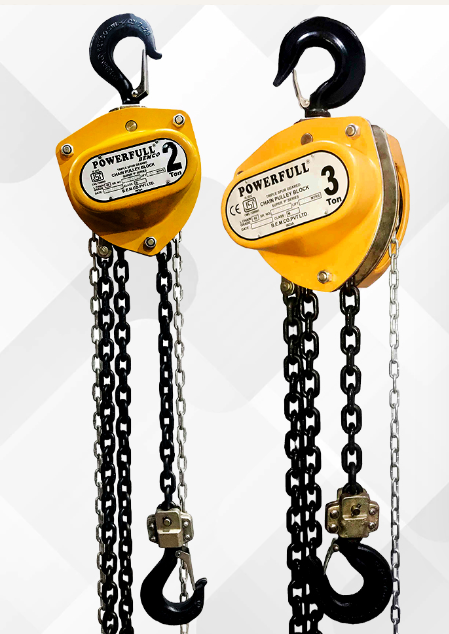
In the realm of lifting and moving heavy loads, manual chain hoists stand as stalwart tools, offering reliability, versatility, and safety. These mechanical marvels have been instrumental in various industries, from construction sites to warehouses, enabling workers to efficiently handle loads that would otherwise be challenging or impossible to manage. This comprehensive guide aims to delve into the world of chain hoists, providing insights into their uses, benefits, and different types.
Introduction to Manual Chain Hoists
Also known as hand chain hoists, these manual hoists are simple yet robust devices designed to lift, lower, and maneuver heavy objects manually. They typically consist of a durable housing, a chain, and a mechanical system that employs gears and pulleys to amplify the force applied by the operator. The operator activates the hoist by pulling on a hand chain, which engages the gears and lifts the load.
Uses of Manual Chain Hoists
Hand chain hoists find applications across a wide range of industries and settings due to their versatility and reliability. Some common uses include:
Construction Sites
In construction, hand chain hoists are indispensable tools for lifting heavy building materials, equipment, and components. They are often used for tasks such as erecting steel beams, positioning precast concrete elements, and hoisting machinery to elevated levels.
Manufacturing Facilities
Manufacturing plants utilize manual chain hoists for various tasks, including loading and unloading machinery, transporting materials within the facility, and assembling large products. These hoists enable workers to handle heavy items safely and efficiently.
Warehousing and Logistics
In warehouses and distribution centers, hand chain hoists facilitate the movement of goods, allowing operators to lift pallets, crates, and other heavy items for storage or loading onto trucks. They are particularly useful in environments where space constraints or lack of power sources limit the use of motorized lifting equipment.
Maintenance and Repair Work
Maintenance technicians and repair personnel rely on manual chain hoists to lift and position machinery for servicing or replacement of components. These hoists offer precise control and maneuverability, making them ideal for intricate tasks that require careful handling.
Entertainment and Event Industry
In the entertainment industry, hand-chain hoists play a crucial role in rigging and stage setup for concerts, theatrical productions, and other events. They are used to lift lighting fixtures, sound equipment, scenery, and other props, ensuring smooth and safe operations behind the scenes.
Benefits of Manual Chain Hoists
Hand chain hoists offer several advantages that make them the preferred lifting solutions in many situations:
Portability and Mobility
One of the key benefits of hand chain hoists is their portability. Since they do not rely on external power sources, they can be easily transported to different work sites or locations within a facility. This mobility makes them ideal for applications where flexibility is essential.
Simple Operation
Manual chain hoists are straightforward to operate, requiring minimal training for users. The hand chain mechanism allows operators to control the lifting process with precision, adjusting the speed and position of the load as needed.
Durability and Reliability
Built with sturdy materials and robust construction, these chain hoists are designed to withstand heavy use in demanding environments. With proper maintenance, they can provide years of reliable service, making them a cost-effective investment for businesses.
Safety Features
Modern manual chain hoists are equipped with various safety features to protect both the operator and the load. These may include overload protection mechanisms, load-limiting devices, and friction brakes that prevent unintentional lowering of the load.
Cost-Effectiveness
Compared to powered lifting equipment, these chain hoists are often more affordable to purchase and maintain. They require no electricity or fuel, reducing operating costs, and they have fewer components that can wear out or require servicing over time.
Types of Manual Chain Hoists
These chain hoists come in several configurations to suit different lifting requirements and preferences. Some common types include:
Lever Hoists
Lever hoists, also known as ratchet hoists or come-along, utilize a lever mechanism to lift and lower loads. They are compact and lightweight, making them ideal for applications where space is limited or portability is crucial. Lever hoists are available in various lifting capacities, from light-duty to heavy-duty models.
Hand Chain Hoists
Hand chain hoists, the most traditional type of manual chain hoist, feature a hand chain that the operator pulls to raise or lower the load. They offer precise control and are suitable for lifting heavy loads in a controlled manner. Hand chain hoists are available in different configurations, including single-chain and double-chain models, with varying lifting capacities.
Geared Trolleys
Geared trolleys are manual hoisting devices that incorporate a trolley mechanism for horizontal movement along a beam or track. They are commonly used in conjunction with hand chain hoists or lever hoists to transport loads across a workspace or between different areas of a facility. Geared trolleys are available in push or hand-geared versions, with adjustable widths to accommodate various beam sizes.
Chain Blocks
Chain blocks, also known as block and tackle hoists, consist of multiple pulleys and chains arranged in a block configuration. They provide mechanical advantage, allowing users to lift heavy loads with minimal effort. Chain blocks are often used in applications where high lifting heights or heavy loads require additional lifting power.
Conclusion
Manual chain hoists are the ultimate tools in numerous industries, offering versatility, reliability, and safety in lifting and moving heavy loads. Whether on construction sites, in manufacturing facilities, or at entertainment events, these mechanical marvels provide the muscle needed to tackle challenging tasks with ease. By understanding their uses, benefits, and different types, businesses and workers can make informed decisions when selecting the appropriate chain hoist for their specific needs.





